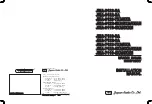
For product support please see www.digitalyacht.co.uk
Page 18
AIT2000 Installation & Operation Manual
VERSION 1.01
A multiplexing feature is provided, which means any messages which are received on the low speed Input
2 port are automatically transmitted on the high speed Output 1 port. This is particularly useful when us-
ing a chart plotter having only a single NMEA0183 port.
Instrument data or additional sensors such as a gyro-compass can be connected to the AIS transponder
via the low speed port and all of this data, plus the AIS and GPS data will be transmitted on the high speed
Output 1 port to the chart plotter. Please ensure your equipment is configured to use the correct baud
rate for the port it is connected to.
On many vessels fitted with a modern VHF Radio that requires GPS data for the DSC functions, the low
speed NMEA Output 2 can be used to give GPS data to the VHF radio. On this port are the following
common NMEA 0183 GPS position sentences; GLL, GGA and RMC.
Figure 6 below is a diagram of a typical installation showing the NMEA 0183 data connections. The Head-
ing data (or any instrument data) received on Input 1 is multiplexed (combined) with the AIT2000’s own
AIS and GPS data and sent to the Chart Plotter on Output 1 (38400 baud). The GPS inside the AIT2000 is
used to provide the VHF DSC radio with GPS position data on Output 2 (4800 baud).
Figure 6












































